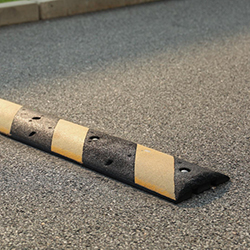Benefits of Reducing Speeds
The implementation of traffic calming measures such as speed bumps and humps has a direct correlation with enhanced road safety.
Reduced vehicle speeds significantly lower the risk of accidents and the severity of any potential collisions.
- Pedestrian safety is greatly improved, especially in residential areas and school zones where children are present.
- Lower speeds facilitate a more predictable traffic environment, allowing all road users to react appropriately to unexpected events.
- The noise pollution typically associated with high-speed traffic is also diminished, contributing to a more peaceful community atmosphere.
Furthermore, the strategic placement of these devices encourages drivers to remain vigilant and attentive, fostering a culture of safe driving that extends beyond the immediate vicinity of the speed control measures.
Potential Drawbacks and Community Concerns
While traffic calming measures like speed humps are designed to enhance safety, they can also introduce new challenges.
Emergency response times can be affected, as speed humps impede the progress of emergency vehicles. This is a significant concern for communities, as every second counts in a crisis.
Moreover, maintenance vehicles such as snow plows may face difficulties navigating roads with speed humps. The presence of these structures can disrupt the efficiency of snow removal, leading to less accessible streets during winter months. Additionally, the design and installation quality of speed humps are crucial; poorly constructed humps can cause damage to personal vehicles, which can lead to frustration and potential repair costs for vehicle owners.
Residents and local businesses may also voice concerns regarding increased noise and vibrations as vehicles traverse over the humps. It’s important for city planners to weigh these potential drawbacks against the intended safety benefits when considering the implementation of traffic calming measures.
Studies and Statistics on Traffic Calming Efficacy
Numerous studies have been conducted to assess the effectiveness of traffic calming measures like speed bumps and humps.
The consensus is clear: properly implemented traffic calming devices can significantly reduce vehicle speeds and improve safety for pedestrians and cyclists.
Key findings from research include:
- A reduction in accident rates, particularly those involving vulnerable road users.
- Lower vehicle speeds leading to a decrease in the severity of accidents when they do occur.
- Enhanced quality of life for residents in neighborhoods where traffic calming measures are in place.
However, it’s important to note that the success of these devices can vary based on a range of factors, including the type of road, volume of traffic, and the specific design of the traffic calming measure. Ongoing evaluation and adjustments are often necessary to ensure the best outcomes for safety and traffic flow.
Installation and Maintenance of Traffic Calming Measures
Materials and Methods for Longevity
The longevity of traffic calming devices such as speed bumps and humps is heavily dependent on the
materials and construction methods used. High-quality, durable materials are essential, particularly in areas with varied weather conditions. For instance, modular rubber is a popular choice for traffic calming designs due to its resilience and adaptability.
When installing traffic calming measures, it’s important to follow a systematic approach:
- Assess the site-specific requirements, including traffic volume and road surface conditions.
- Choose materials that are suited to the local climate and expected wear and tear.
- Employ professional installation techniques to ensure the devices are securely anchored and aligned.
Regular maintenance is also crucial to preserve the functionality and appearance of speed bumps and humps. This includes routine inspections, cleaning, and timely repairs of any damage incurred over time.
Maintenance Responsibilities and Costs
The upkeep of traffic calming devices such as speed bumps and humps is crucial for their effectiveness and longevity.
Responsibility for maintenance typically falls on the local government or the property owner, depending on the location of the device. Regular inspections are necessary to ensure that these measures continue to meet safety standards and function as intended.
Maintenance activities can include:
- Repainting faded markings to ensure visibility
- Repairing wear and tear or damage from vehicles and weather
- Clearing debris that may obstruct the effectiveness of the device
Costs associated with maintenance can vary widely. Factors influencing the cost include the material of the traffic calming device, the frequency of required maintenance, and the extent of any damage that needs to be repaired. In some cases, community groups may volunteer to share in the upkeep, which can help reduce the financial burden on local authorities.
Upgrading or Removing Traffic Calming Devices
The decision to upgrade or remove traffic calming devices often arises from changes in traffic patterns or community needs.
Upgrades may be necessary to enhance effectiveness or to comply with updated safety standards.
When considering the removal of speed bumps or humps, it’s important to evaluate the impact on traffic speed and safety. The process typically involves:
- Conducting a traffic study to assess current conditions.
- Consulting with local residents and stakeholders.
- Reviewing accident and speed data pre- and post-installation.
If removal is approved, the process should be carried out by professionals to ensure the road surface is restored to a safe condition. Upgrading devices may include installing new signage, repainting, or replacing with more advanced systems. The goal is always to balance the needs of all road users while maintaining safe travel conditions.
Conclusion
Understanding the nuances of traffic calming measures is crucial for creating safer and more pleasant neighborhoods. Speed bumps and humps, while often used interchangeably in conversation, serve distinct purposes and are designed with specific dimensions to match their intended use. The knowledge of their differences—speed bumps being shorter in width and more aggressive in slowing down vehicles, and speed humps being wider and more gradual—empowers citizens to advocate for appropriate traffic management in their communities. As we have explored, the choice between a speed bump and a speed hump can significantly influence the flow and safety of traffic, making it an important consideration for urban planning and community well-being.

